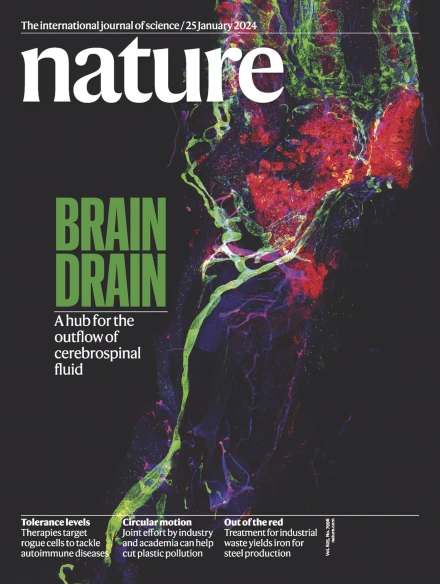巨噬细胞用谷氨酸刺激肌肉纺锤体以促进运动
IF 48.5
1区 综合性期刊
Q1 MULTIDISCIPLINARY SCIENCES
引用次数: 0
摘要
拉伸反射是运动系统的一个基本组成部分,它协调了潜在运动的肌肉收缩。这一过程的核心是肌纺锤体(MS),这是一种特殊的感受器,能很好地适应肌内纤维张力的波动。MS中的张力变化触发了一系列神经元事件,包括感觉Ia型传入事件的初始去极化,随后导致脊髓内运动神经元的激活1,2。这种神经元级联在肌肉收缩的执行中达到高潮,强调了肌肉骨骼系统和神经系统之间的闭环机制。相比之下,我们在这里报告了一种新的巨噬细胞群的发现,这些巨噬细胞在MS中具有独特的分子和功能特征,表达谷氨酸的合成和释放机制。利用小鼠交叉遗传学、光遗传学和电生理学,我们发现MS巨噬细胞(MSMP)的激活驱动本体感觉神经元在毫秒时间尺度上放电。MSMP通过谷氨酸依赖机制激活脊髓回路、运动神经元和肌肉,从而激活ms。此外,MSMP通过增加谷氨酰胺酶的表达来响应神经和肌肉的激活,使它们能够将肌细胞在肌肉收缩过程中释放的摄取的谷氨酰胺转化为谷氨酸。后肢肌肉中MSMP的选择性沉默或消耗破坏了拉伸反射对力产生和感觉反馈纠正的调节,损害了小鼠的运动策略。我们的研究结果已经确定了一种新的细胞成分,MSMP,它直接调节神经活动和肌肉收缩。谷氨酸介导的MSMP信号传导及其对感觉线索的动态反应为我们对感觉和运动动作的理解引入了一个新的维度,可能为影响感觉运动功能的疾病提供创新的治疗方法。本文章由计算机程序翻译,如有差异,请以英文原文为准。


Macrophages excite muscle spindles with glutamate to bolster locomotion
The stretch reflex is a fundamental component of the motor system that orchestrates the coordinated muscle contractions underlying movement. At the heart of this process lie the muscle spindles (MS), specialized receptors finely attuned to fluctuations in tension within intrafusal muscle fibres. The tension variation in the MS triggers a series of neuronal events including an initial depolarization of sensory type Ia afferents that subsequently causes the activation of motoneurons within the spinal cord1,2. This neuronal cascade culminates in the execution of muscle contraction, underscoring a presumed closed-loop mechanism between the musculoskeletal and nervous systems. By contrast, here we report the discovery of a new population of macrophages with exclusive molecular and functional signatures within the MS that express the machinery for synthesizing and releasing glutamate. Using mouse intersectional genetics with optogenetics and electrophysiology, we show that activation of MS macrophages (MSMP) drives proprioceptive sensory neuron firing on a millisecond timescale. MSMP activate spinal circuits, motor neurons and muscles by means of a glutamate-dependent mechanism that excites the MS. Furthermore, MSMP respond to neural and muscle activation by increasing the expression of glutaminase, enabling them to convert the uptaken glutamine released by myocytes during muscle contraction into glutamate. Selective silencing or depletion of MSMP in hindlimb muscles disrupted the modulation of the stretch reflex for force generation and sensory feedback correction, impairing locomotor strategies in mice. Our results have identified a new cellular component, the MSMP, that directly regulates neural activity and muscle contraction. The glutamate-mediated signalling of MSMP and their dynamic response to sensory cues introduce a new dimension to our understanding of sensation and motor action, potentially offering innovative therapeutic approaches in conditions that affect sensorimotor function. A population of macrophages with exclusive molecular and functional signatures in the muscle spindles express machinery for synthesizing and releasing glutamate, and a cellular component, the muscle spindle macrophages, directly regulates neural activity and muscle contraction.
求助全文
通过发布文献求助,成功后即可免费获取论文全文。
去求助
来源期刊

Nature
综合性期刊-综合性期刊
CiteScore
90.00
自引率
1.20%
发文量
3652
审稿时长
3 months
期刊介绍:
Nature is a prestigious international journal that publishes peer-reviewed research in various scientific and technological fields. The selection of articles is based on criteria such as originality, importance, interdisciplinary relevance, timeliness, accessibility, elegance, and surprising conclusions. In addition to showcasing significant scientific advances, Nature delivers rapid, authoritative, insightful news, and interpretation of current and upcoming trends impacting science, scientists, and the broader public. The journal serves a dual purpose: firstly, to promptly share noteworthy scientific advances and foster discussions among scientists, and secondly, to ensure the swift dissemination of scientific results globally, emphasizing their significance for knowledge, culture, and daily life.
 求助内容:
求助内容: 应助结果提醒方式:
应助结果提醒方式:


